This pub is named after Carmarthen’s most famous landmark, Yr Hen Dderwen, which stood in Priory Street for more than 300 years.
Text about the history of Yr Hen Dderwen.
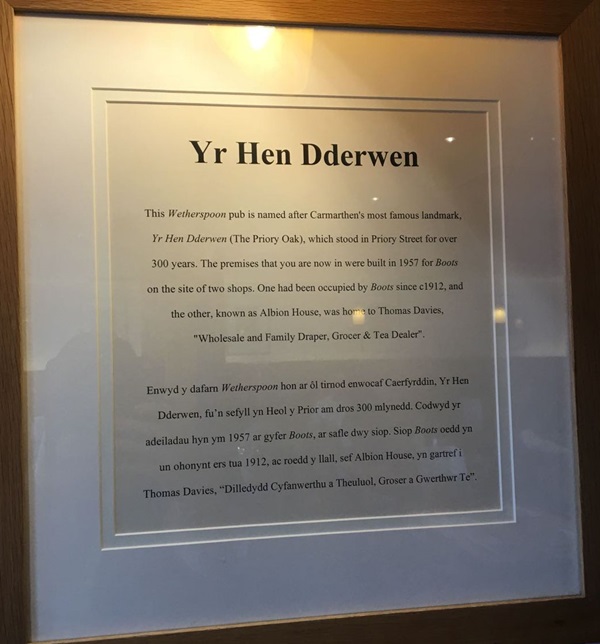
The text reads: This Wetherspoon pub is named after Carmarthen’s most famous landmark, Yr Hen Dderwen (The Priory Oak), which stood in Priory Street for over 300 years. The premises that you are now in were built in 1957 for Boots on the site of two shops. One had been occupied by Boots since c1912, and the other, known as Albion House, was home to Thomas Davies, Wholesale and Family Draper, Grocer & Tea Dealer’.
Illustrations of Carmarthen in the early days.

Top: St Peter’s Church
Above: The Parade, 1874, marking the southern boundary of Roman Moridunum
Below: Carmarthen, 1610.
Prints and text about Yr Hen Dderwen.
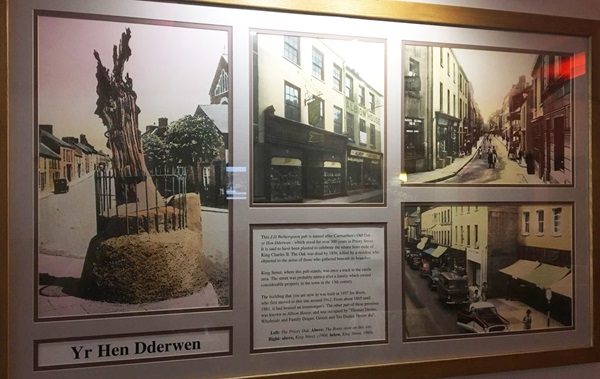
The text reads: This J D Wetherspoon pub is named after Carmarthen’s Old Oak – Yr Hen Dderwen – which stood for over 300 years in Priory Street. It is said to have been planted to celebrate the return from exile of King Charles II. The Oak was dead by 1856, killed by a resident who objected to the noise of those who gathered beneath its branches.
King Street, where this pub stands, was once a track to the castle area. The street was probably named after a family which owned considerable property in the town in the 13th century.
The building that you are now in was built in 1957 for Boots, who first moved to this site around 1912. From about 1865 until 1881, it had housed an ironmongers’. The other part of these premises was known as Albion House, and was occupied by Thomas Davies, Wholesale and Family Draper, Grocer and Tea Dealer, Hosier.
Left: The Priory Oak
Above: The Boots store on this site
Right: above, King Street, c1900, below, King Street, 1960s.
Prints and text about military matters.
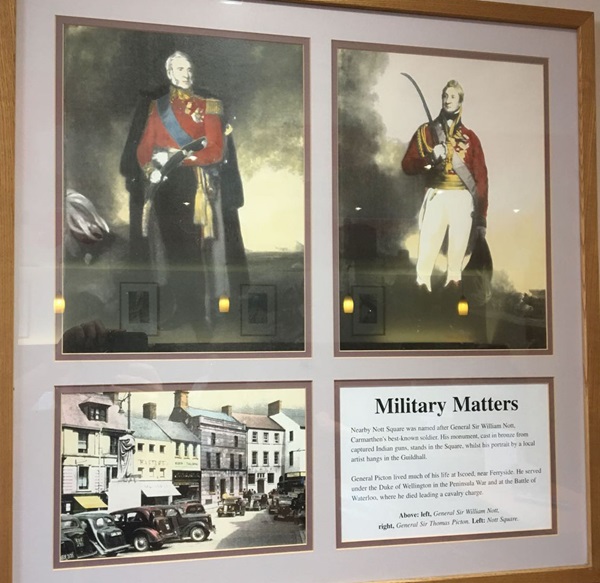
The text reads: Nearby Nott Square was named after General Sir William Nott, Carmarthen’s best-known soldier. His monument, cast in bronze from captured Indian guns, stands in the square, whilst his portrait by a local artist hangs in the Guildhall.
Above: left, General Sir William Nott, right, General Sir Thomas Picton
Left: Nott Square.
Illustrations and text about Merlin.
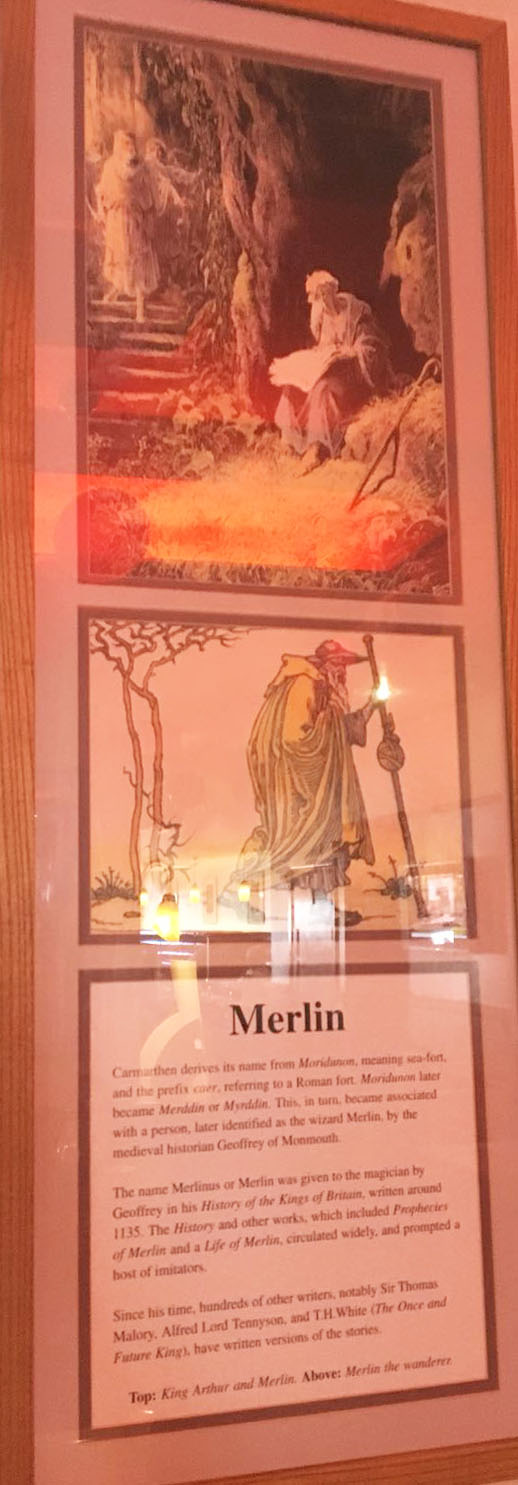
The text reads: Carmarthen derives its name from ‘Moridunon’, meaning sea-fort, and the prefix ‘caer’, referring to a Roman fort. Moridunon later became Merddin or Myrddin. This, in turn, became associated with a person, later identified as the wizard Merlin, by the medieval history Geoffrey of Monmouth.
The name Merlinus or Merlin was given to the magician by Geoffrey in his History of the Kings of Britain, written around 1135. The History and other works, which included Prophecies of Merlin and a Life of Merlin, circulated widely, and prompted a host of imitators.
Since his time, hundreds of other writers, notably Sir Thomas Malory, Alfred Lord Tennyson, and TH White (The Once and Future King), have written versions of the stories.
Top: King Arthur and Merlin
Above: Merlin the wanderer.
Prints and text about the history of Carmarthen.
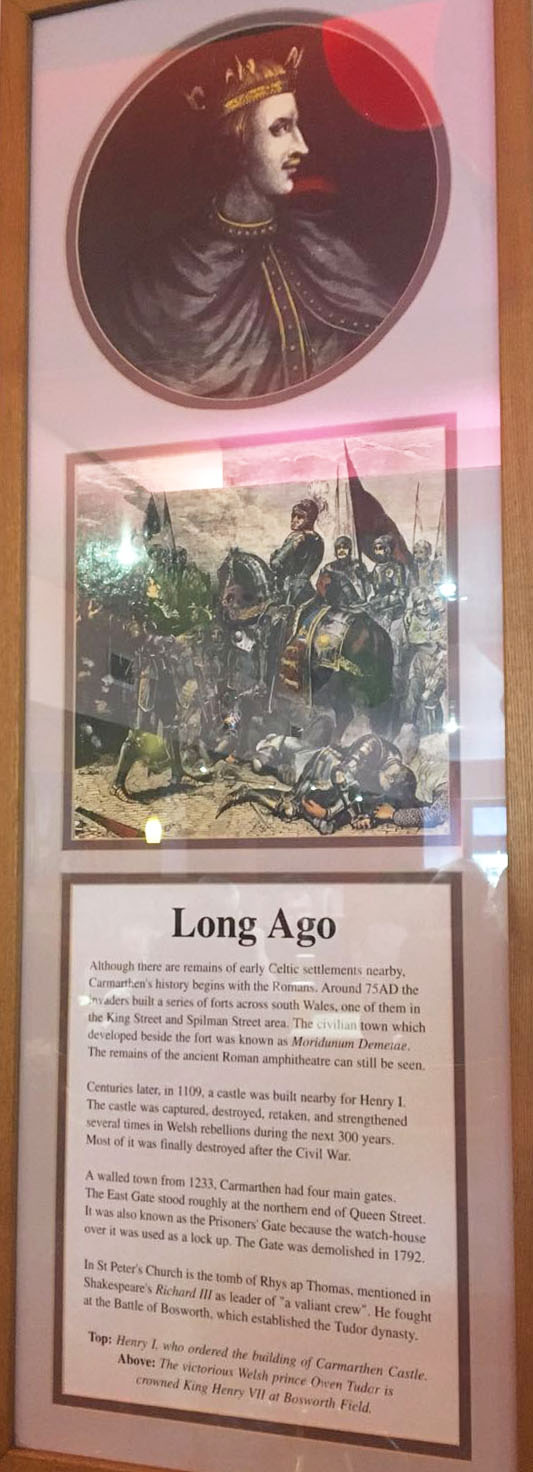
The text reads: Although there are remains of early Celtic settlements nearby, Carmarthen’s history begins with the Romans. Around 75AD the invaders built a series of forts across south Wales, one of them in the King Street and Spilman Street area. The civilian town which developed beside the fort was known as Moridunum Demetae. The remains of the ancient Roman amphitheatre can still be seen.
Centuries later, in 1109, a castle was built nearby for Henry I. The castle was captured, destroyed, retaken, and strengthened several times in Welsh rebellions during the next 300 years. Most of it was finally destroyed after the Civil War.
A walled town from 1233, Carmarthen had four main gates. The East Gate stood roughly at the northern end of Queen Street. It was also known as the Prisoner’s Gate because the watch house over it was used as a lock up. The gate was demolished in 1792.
In St Peter’s Church is the tomb of Rhys ap Thomas, mentioned in Shakespeare’s Richard III as leader of ‘a valiant crew’. He fought at the Battle of Bosworth, which established the Tudor dynasty.
Top: Henry I, who ordered the building of Carmarthen Castle
Above: The victorious Welsh prince Owen Tudor is crowned King Henry VII at Bosworth Field.
Illustrations and text about trade and industry.
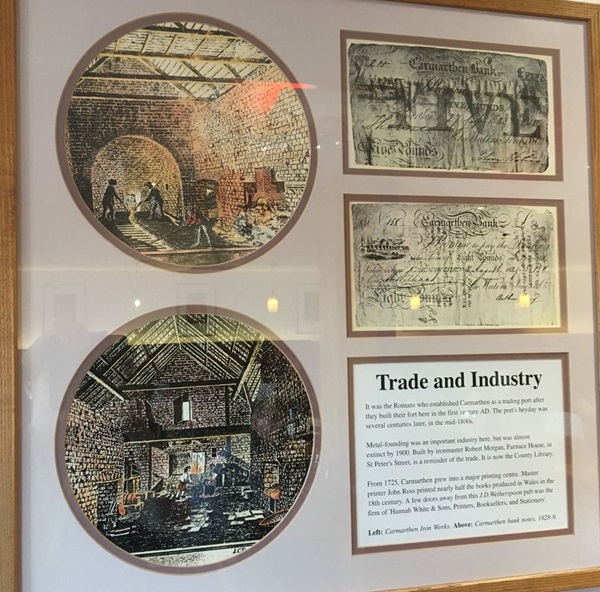
The text reads: It was the Romans who established Carmarthen as a trading port after they built their fort here in the first century AD. The port’s heyday was several centuries later, in the mid 1800s.
Metal-founding was an important industry here, but was almost extinct by 1900. Built by ironmaster Robert Morgan, Furnace House, in St Peter’s Street, is a reminder of the trade. It is now the county library.
From 1725, Carmarthen grew into a major printing centre. Master printer John Ross printed nearly half the books produced in Wales in the 18th century. A few doors away from this J D Wetherspoon pub was the firm of Hannah White & Sons, Printers, Booksellers, and Stationers.
External photograph of the building – main entrance.
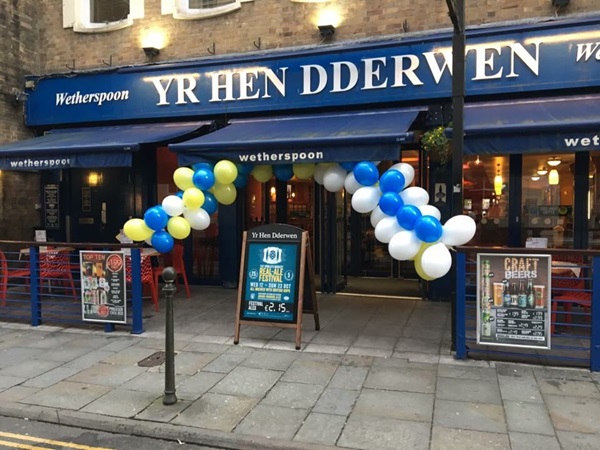
If you have information on the history of this pub, then we’d like you to share it with us. Please e-mail all information to: pubhistories@jdwetherspoon.co.uk